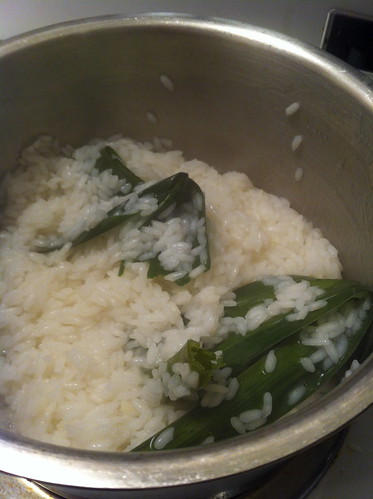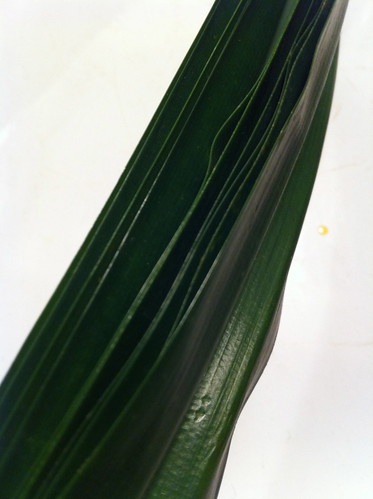Pandan Leaves (Pandanus odoratissimus)
You might have tasted Pandan without even knowing it. It's used primarily in Southeast Asian cuisine, in almost all desserts, so much so that it's been coined the "vanilla of the east"*, i.e.: in coconut custard, and mango sticky rice, a very popular Thai dessert, is in fact cooked with pandanus leaves, tied in a knot and removed once its sweet aroma has been infused into the rice and the coconut milk, and of course there are the less traditional but not any less popular pandan flavoured ice cream and gelato, and other simple custard-like European desserts such as Crème brûlée and panna cotta. It can also be wrapped around rice, and steamed, much in the same way as banana leaf, imparting a smooth fragrant aroma that is complementary to the rice.
Pandan leaves behind it a fine, subtle aroma that is so representative of Asian cuisine and aromatics: the aroma is reminiscent of roasted tea leaves, milky oolong, almond cream and basmati rice. And the taste is subtly sweet, like the smooth finish of fine green and oolong teas - sweet at the back of the mouth and the top of the palate.
You can incorporate it rather easily into dishes, savoury or sweet, by tying them into a knot and infusing the liquids with it; or using pandan essence (can be found in some Asian markets and grocery stores), or create your own pandan "juice" by covering cut leaves with water, and blitzing them in a food processor, followed by straining. You'll get a green juice that can be used just like vanilla extract in baking cakes (and won't turn it green either, just like vanilla extract won't turn your whipped cream black!).

Kewda attar, from the pandanus flower oil which is either macerated with sesame seeds or oils, or distilled into sandalwood oil, produces a fine and unique essence. Kewda attar is distinct, exotic, floral, reminiscent of a tropical jungle and flowers all at once. Kewda is extremely heady, and may be perceived as sharp when first smelled. The sharpness being somewhat green, and mostly reminiscent of horseradish. However, the sharpness is underlined by a unique sweetness and warmth. The scent of kewda is unlike any other scent, though some may compare its dry out sweetness to that of hyacinth. The main constituent responsible for its characteristic scent is beta-phenylethyl alcohol(which makes up to 60-80% of the oil). Kewda is mostly used in Indian traditions as a perfume and as a medicine, and hardly made its way to Western perfumery.

Although pandanus flowers (aka kewda or kewra) are very popular perfume material in India, I could not find any documentation on using the leaves for perfumery. Out of curiousity, and rather on an impluse, I have began to tincture pandanus leaves in a jar of ethanol and am now crossing my fingers, hoping for the best.

* Interestingly enough, the plants of pandanus have also been used as the foundation to support vanilla orchids in the plantations in Madagascar and the Reunion Islands.
Labels: Decoding Obscure Notes, Keora, Kewra, Pandan, Pandanus, Screwpalm, Screwpine




6 Comments:
What beautiful photographs!!
Is that all your own work?
Exquisite - you have made The Dandy most devilishly envious!
Yours ever
The Perfumed Dandy
This is so interesting. I'm on holiday in Malaysia and in the spa they macerate pandan leaves and put it in a bath with milk and the smell is divine. How did it go tincturing the pandan leaf?
Perfumed Dandy,
Of course that is all my doing in the photograph. Easy to make :-)
Jane,
I'm jealous of your Malaysian holiday - sounds superb! The tincture turned out marvellous. I will be using it in a perfume in the future; and also using it as an extract for flavour in the kitchen. You have to be using a food grade alcohol for that though!
So glad it worked out well and you can use it both for perfume and cooking. How did you go about it - did you macerate it first or just put the whole leaf in there and pour alcohol on top?
This comment has been removed by the author.
I'm sort of interested about making perfumes out of pandan leaves and I've seen your photo showing that you made some of it. Is it successful enough to satisfy one's point of smell? And is it smelly? :)
Post a Comment
<< Home